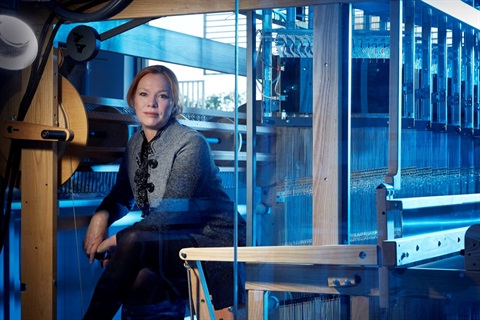Renaissance engineer Melissa Knothe Tate a CrossXpollinatioN feature
Published on 02 July 2018

Renaissance engineer Professor Melissa Knothe Tate, who dreams to one day teach human cells how to weave tissue regeneration and repair, is CrossXpollinatioN’s 2018 headline artist.
A collection of Prof Knothe Tate’s multifunctional textiles that mimic the natural cellular weaves of living tissues will be on display at this year’s exhibition at COPACC from July 7-29.
Special for the CrossXPollinatioN exhibit, Prof Knothe Tate has created a woven tapestry sculpture, ‘Ensconced in my own fabric’.
The giant piece represents a bone's tissue weave, scaled up so that the viewer becomes the size of the cell, delving deeper into the folds of its own fabric, which are woven from scaled-up structural proteins, including collagen and elastin.
Prof Knothe Tate created the piece to enable the public to empathise with their cells and to grasp how an appreciation of the mechanisms underpinning the world around them can cultivate discovery as well as creative processes and thereby innovation.
Acting COPACC Manager Tamzin McLennan said the Sydney biomedical engineer was known for turning art and science on their heads.
Prof Knothe Tate uses the term ‘biotextilogy’ to represent the patterns created by the arrangement of collagen, elastin and other structural proteins within our bodies. Different patterns result in different material properties.
By scaling-up these patterns, it is possible to weave advanced materials for sportswear, medical devices and safety and transport industries that mimic the properties of structural proteins, for example; elasticity, strength and wear resistance.
Prof Knothe Tate was recently recognised as one of Australia's most Innovative Engineers 2017 for her geospatial and navigation approaches (using Google Maps) to understand the cellular inhabitants of complex biosystems including the human hip.
Ms McLennan said Prof Knothe Tate’s work would inspire CrossXpollinatioN followers to think beyond the aesthetics of fibre and textiles to the limitless potential they possess.
“The work that Prof Knothe Tate and her colleagues are doing in the lab might one day result in the creation of a ‘living loom’ – that is, the weaving of human body parts inside the body,” Ms McLennan said.
Prof Knothe Tate is also offering an artist talk as part of CrossXpollinatioN, on Saturday July 7 at 2pm. In this talk, she will discuss her work, where science and weaving meet. The artist talk is free but RSVPs are required as space is limited. Please RSVP by Friday, July 6 to copacc@colacotway.vic.gov.au or 5232 9418. CrossXpollinatioN is proudly presented by COPACC and RRRTAG and is sponsored by Tarndie, Irrewarra Sourdough and Star Printing.